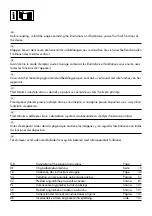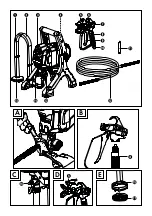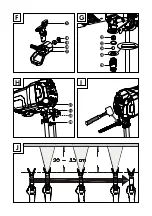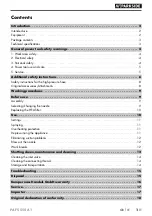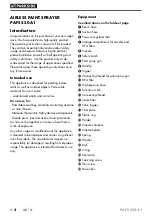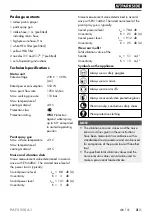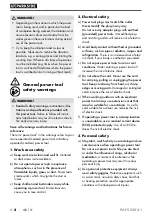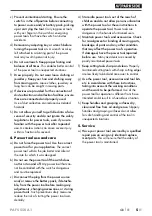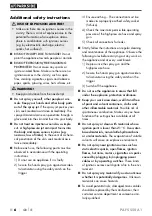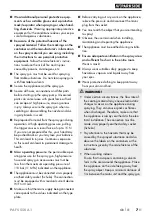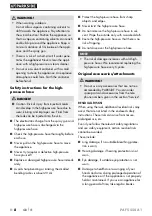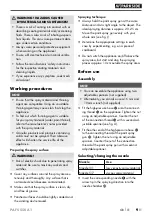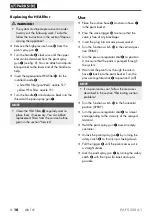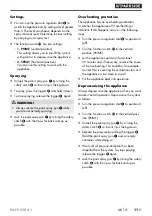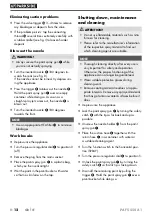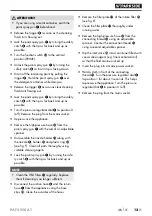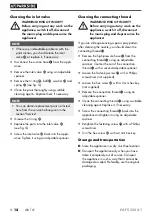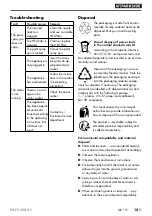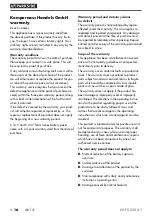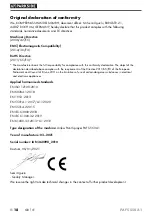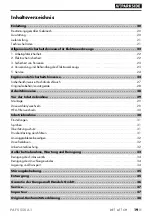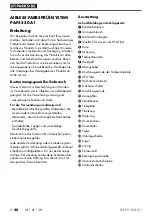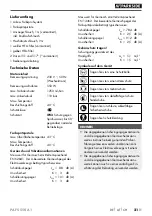
PAFS 550 A1
■
6
│
GB
│
IE
Additional safety instructions
RISK OF EXPLOSION AND FIRE!
►
Make sure there are no ignition sources in the
vicinity . There is a risk of explosion due to the
potential formation of an explosive atmos-
phere in combination with ignition sources
(e .g . by electrostatic discharge, electric
sparks, hot surfaces)!
■
RISK OF INJURY! DUE TO MISUSE!
Do not
point the appliance towards people or animals .
■
RISK OF EXPLOSION/FIRE! SMOKING
PROHIBITED!
Do not cause any sparks or
ignite a naked flame . Make sure there are no
ignition sources in the vicinity, such as open
fires, smoking cigarettes, cigars and tobacco
pipes, sparks, glowing wires, hot surfaces, etc .
WARNING!
►
Keep your distance from the nozzle tip!
■
Do not spray yourself, other people or ani-
mals. Keep your hands and other body parts
out of the spray jet.
If the spray jet pierces your
skin, seek medical assistance immediately . The
sprayed material can even penetrate through a
glove and into the skin and thus into your body .
■
Do not treat an injection wound as a simple
cut. A high-pressure jet can inject toxins into
the body and cause serious injuries (e.g.
necrosis, loss of limbs).
In the event of a chemi-
cal penetration of the skin, seek medical assis-
tance immediately .
■
Before each use, the following points must be
observed in accordance with the operating
instructions:
1) Do not use an appliance if it is faulty .
2) Secure the hand spray gun against acciden-
tal activation using the safety catch on the
trigger .
3) Ensure earthing – The connection must be
made via a properly earthed safety socket
(Schuko) .
4) Check the maximum permissible operating
pressure of the high-pressure hose and spray
gun .
5) Check all connections for leaks .
■
Strictly follow the instructions on regular cleaning
and maintenance of the appliance . Observe the
following rules before carrying out any work on
the appliance and at every work break:
1) Depressurise the spray gun and the
high-pressure hose .
2) Secure the hand spray gun against acciden-
tal activation using the safety catch on the
trigger .
3) Switch off the appliance .
■
Do not use the appliance in areas that fall
under the explosion protection ordinance.
■
Keep your work area clean, well lit and free
of paint and solvent containers, cloths and
other inflammable materials.
Possible risk of
spontaneous combustion . Make sure you have
functional fire extinguishers available at all
times .
■
Do not spray or clean with materials whose
ignition point is lower than 21°C. Use water-
based materials, non-volatile hydrocarbons
or similar materials.
The evaporation of volatile
solvents will cause an explosive environment .
■
Do not spray near ignition sources such as
static electric sparks, open flames, ignition
flames, hot items, motors, cigarettes or sparks
caused by plugging in/unplugging power
cables or by operating switches.
These kinds
of ignition sources could ignite a fire in the envi-
ronment .
■
Do not spray any material if you do not know
whether it is potentially dangerous.
Unknown
materials can cause hazards .
■
To avoid potential risks, damaged mains cables
should be replaced by the manufacturer, their
customer service department or someone simi-
larly qualified .
Summary of Contents for 360098 2010
Page 3: ...A B C D E...
Page 4: ...F G H I J...
Page 64: ...PAFS 550 A1 60 FR BE...
Page 84: ...PAFS 550 A1 80 NL BE...
Page 104: ...PAFS 550 A1 100 CZ...
Page 144: ...PAFS 550 A1 140 SK...


